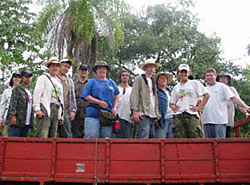 |






|
 |

 |
 |
 |
 |

The entire Earthwatch Team 6 in the Pantanal in February 2004. |
 |
 |
 |
2004 Update
From Earthwatch Team 6, Pantanal, Feb 14–25, 2004
This year was the wettest season the scientists have experienced since 2000. "All the water was unbelievable!" reports Jeff Wilford, a team member and teacher from Maine.
"This made travel very tricky, and we became stuck on several occasions. Even being stuck at night in the middle of the Pantanal offered us an unexpected sensory experience. The animals were so loud! The fireflies were like nothing I had ever experienced before — like fireworks!"
The team of 15 educators from Brazil, Maine, Massachusetts, Mississippi, Rhode Island, and Washington focused on several research tasks.
With Dr. Alexine Keuroghlian, they tracked peccaries and wild pigs. Most of this work was done driving around in the back of a jeep trying to locate the radio signals of peccaries and wild pigs that had radio collars attached to them. By taking GPS readings at two locations where a signal was the strongest, they could use triangulation to figure out the exact location of a peccary on a map. By plotting the locations on a map over time, they can compare wet and dry season changes in the animals' home ranges
The highlight for Donna Glick from Washington and Bobbie Richardson from Mississippi was when they got to track peccaries from a tiny plane with the doors open.
Team members also helped Don Eaton, an aquatic specialist, collect data on the many different water habitats including the Rio Negro River, fresh water lakes, and salt water lakes. By establishing baseline information on the diversity of fish and other organisms in these areas, scientists will be better able to monitor the changes from season to season and identify areas that are threatened.
Ellen Wang, the reptile and amphibian scientist showed the team a simple method for catching snakes and frogs. Deep holes were dug in the ground, large enough to place a garbage can. A black fence was constructed across the center of the can. The creatures would run into the fence, and then fall into the can.
The team also helped Ellen collect fruit samples as part of an ongoing study to understand what the animals are eating. Fruit is one of the main food sources and healthy fruit populations ensure a thriving ecosystem. Most of the predators rely on fruit eating animals for food. The jaguar's reliance on the peccary is an excellent example.
With Vitor Rademaker team members baited and checked traps to catch small mammals. Team members would then weigh and measure the animal and check for disease. The animal would then would be released. Most of the animals were rodents and marsupials.
A full report of daily activities and animals including photos can be found at:
http://www.esd189.org/tlp/pantanal.
Photos
courtesy of Earthwatch Institute
|
 |
|
|
|
|
 |

